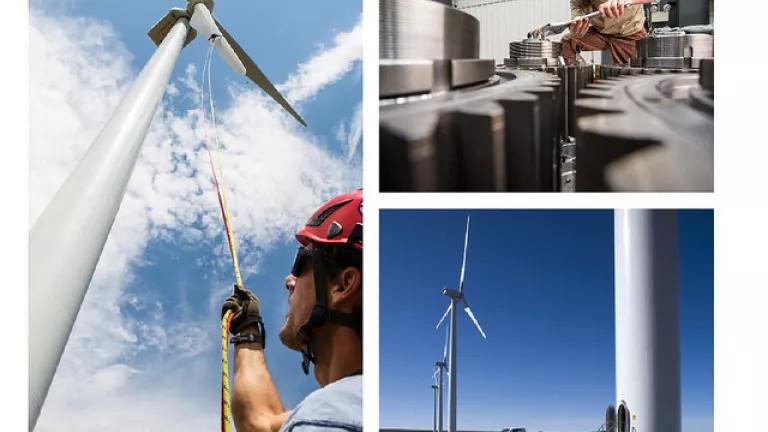
As the world’s greatest athletes compete down in Rio this week, the U.S. wind industry is also breaking records of its own. And I’m not even talking here about standout, new projects announced in the last couple of months by MidAmerican Energy and Alliant Energy that can help the state of Iowa get more than 40 percent of its electricity from wind power, or the legislation just signed into law in Massachusetts that will mean the Bay State gets 1,600 megawatts of pollution-free offshore wind power in a little more than 10 years.
The records I’m referring to were reported out today in the U.S. Department of Energy’s annual Wind Technologies Market Report, compiled by researchers at Lawrence Berkeley National Laboratory (LBNL). Here’s the really great news they offer for our climate, our economy, and our public health:
New wind projects were the number one source of new electric capacity last year, representing 41 percent of all new generating capacity. Employment in the industry hit a record high, too—88,000 jobs. And that’s not all: The industry set new low prices last year—providing clean, zero-carbon electricity at an astonishingly low average price of $20 per megawatt hour, which is cheaper than any other new form of power generation. To cap it all off, in December, Congress passed a multi-year extension of the Production Tax Credit (PTC), finally providing long-term policy certainty that will further bolster the industry’s growth opportunities.
Some of the key factors driving the industry’s gold medal performance last year include:
Developers are finding innovative ways to improve project performance. The average 2015 capacity factor of projects completed in 2014 was 41.2 percent, compared to an average of 31.2 percent for projects built between 2004 and 2011. These performance gains were driven largely by turbine design improvements, with developers taking advantage of larger rotor diameters that capture more energy. Developers are also moving to higher hub heights that can access stronger winds present at higher altitudes, and to sites with stronger wind resources.
Even while performance is improving, project costs are declining. Driven by decreases in turbine prices, the average total costs of installing a wind project fell to $1640 per kilowatt, or 27 percent below their peak costs in 2009 and 2010.
Wind electricity prices have reached an all-time low. The improvements in performance and the cost reductions described above, as well as continued state and federal support, are helping utilities buy wind power at the all-time average low price of $20 per megawatt hour. With prices that low, wind is the cheapest form of new power generation in many regions of the country.
States and grid operators are gaining more experience with high wind penetrations. Twelve states now have wind penetration of 10 percent or more, with Iowa leading the way with 31 percent of its annual generation coming from wind in 2015. Importantly, grid operators are taking steps to mitigate curtailment – when renewable projects have to reduce output because of overgeneration or congestion on the grid – which will help bring more renewable energy into the nation’s electric grids and and will further improve project economics.
The best news of all, though, might be this: Even coming off this great year in 2015, the wind industry’s strongest years likely still lie ahead. The multi-year extension of the PTC provides important certainty for the industry (as opposed to the boom-bust cycle created by the uncertainty of annual extensions in previous legislative packages), and power companies all across the country are making strong, smart investments in this low-cost, zero-carbon resource. In fact, an executive at NextEra Energy, a leading wind power developer, recently declared that “the fundamentals for the North American renewables business have never been stronger.” And a new 600 megawatt project in Colorado that Xcel energy plans to build is projected to save customers $400 million over the 25-year lifetime of the project.
Industry analysts have also projected that total wind and solar capacity will double over the next five years, placing the electricity sector in a great position to meet the goals of the Environmental Protection Agency’s Clean Power Plan (CPP), which establishes the first-ever limits on carbon pollution from power plants. As tax incentives for wind and solar phase down, the CPP will go into effect, driving deployment of pollution-free electricity further and keeping our climate progress on track. Wind, solar, and energy efficiency will all be critically important resources as we accelerate our transition to a low-carbon economy.
Today’s report highlights why states and power companies should continue to support and prioritize investment in clean energy through the next decade and beyond. With the right policy and public support, we can look to the U.S. wind industry, like some of our greatest Olympians, to keep breaking its own records over and over again.
